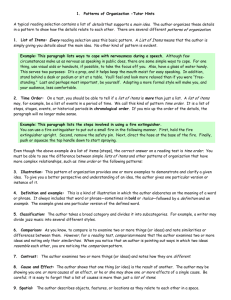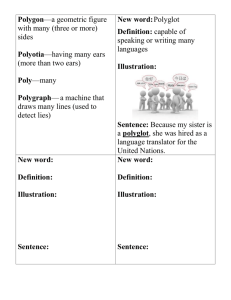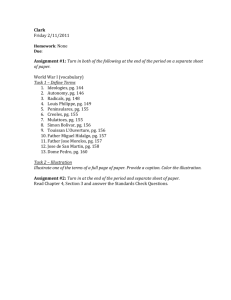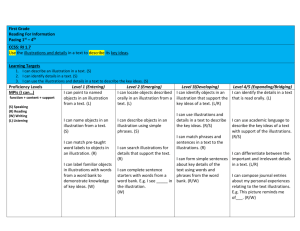TM1: Statutory Money Purchase Illustrations
advertisement
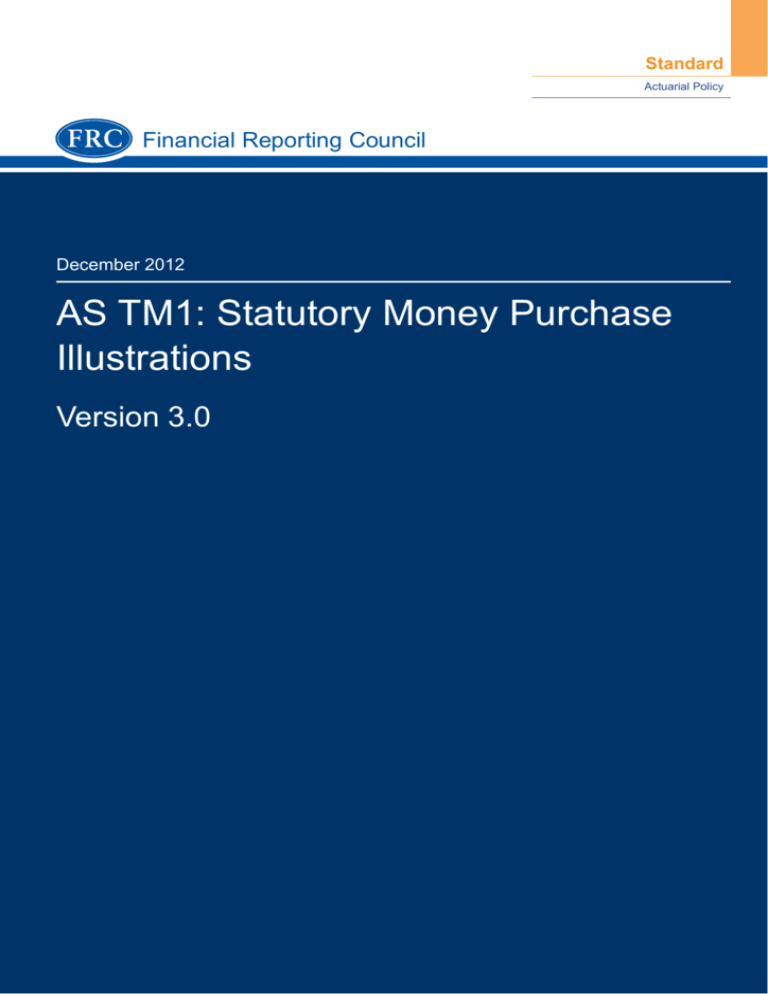
Standard Actuarial Policy Financial Reporting Council December 2012 AS TM1: Statutory Money Purchase Illustrations Version 3.0 The FRC is responsible for promoting high quality corporate governance and reporting to foster investment. We set the UK Corporate Governance and Stewardship Codes as well as UK standards for accounting, auditing and actuarial work. We represent UK interests in international standard-setting. We also monitor and take action to promote the quality of corporate reporting and auditing. We operate independent disciplinary arrangements for accountants and actuaries; and oversee the regulatory activities of the accountancy and actuarial professional bodies. The FRC does not accept any liability to any party for any loss, damage or costs howsoever arising, whether directly or indrectly, whether in contract, tort or otherwise from any action or decision taken (or not taken) as a result of any person relying on or otherwise using this document or arising from any omission from it. © The Financial Reporting Council Limited 2012 The Financial Reporting Council Limited is a company limited by guarantee. Registered in England number 2486368. Registered Office: 5th Floor, Aldwych House, 71-91 Aldwych, London WC2B 4HN. TM1: STATUTORY ILLUSTRATIONS OF MONEY PURCHASE BENEFITS Status Legislation provides that statutory illustrations must be produced in accordance with relevant guidance prepared by a prescribed body. The Financial Reporting Council (FRC) has been appointed as the prescribed body for that purpose. Technical Memorandum TM1: Statutory Money Purchase Illustrations is that relevant guidance. TM1 does not replace or amend the legislation. If it appears that any matter in TM1 conflicts with any provision of the legislation then the latter will prevail. The FRC does not accept any liability to any party for any loss, damage or costs howsoever arising, whether directly or indirectly, whether in contract, tort or otherwise from any action or decision taken (or not taken) as a result of any person relying on or otherwise using this document or arising from any omission from it. Purpose The purpose of TM1 is to specify the assumptions and methods to be used in the calculation of statutory illustrations of money purchase pensions. Application TM1 applies to the production of any statutory illustration. Effective date TM1 version 3.0 is effective for statutory illustrations with an illustration date on or after 6 April 2013. Providers may comply instead with TM1 version 2.0 for statutory illustrations issued before 6 April 2014. Future changes to TM1 The FRC reviews TM1 regularly. It is possible that the methods and assumptions used will be amended as a result. It is likely that some of the assumptions in Part C will be changed from time to time, and providers are strongly advised to take account of the possibility of such changes when devising systems to produce statutory illustrations. Financial Reporting Council 1 CONTENTS Part A B C 2 Page Interpretation 3 A.1 Interpretation of the text 3 A.2 Glossary 3 Determining the amount of pension to be illustrated 6 B.1 Introduction 6 B.2 The amount of pension to be illustrated 6 B.3 Accumulated fund 6 B.4 Current fund 7 B.5 Future contributions 8 B.6 Risk benefits 9 B.7 Annuity rate 10 B.8 General considerations 10 Assumptions 11 C.1 Introduction 11 C.2 Accumulation 11 C.3 Annuity 12 TM1 v3.0 (December 2012) A INTERPRETATION A.1 INTERPRETATION OF THE TEXT A.1.1 This technical memorandum (TM1) should be interpreted in the light of the purpose set out in the rubric on page 1. A.1.2 Providers may adopt a different approach from that specified in TM1 if it does not materially affect the result of the calculation of the statutory illustration. For example, this may apply to the order in which the calculations are carried out. A.1.3 Any assumptions that are used which are not specified in TM1 should be appropriate to the purpose of TM1 set out in the rubric on page 1. Such assumptions might include the valuation of property assets or the treatment of contributions if payment records are incomplete. A.1.4 If a member’s current fund is invested in a with-profits fund (including with-profits deferred annuity contracts) the statutory illustration should be provided in a manner consistent with TM1 and with the insurer’s bonus policy. A.2 GLOSSARY A.2.1 Terms appearing in bold in the text are used with these meanings: accumulation rate The annual rate of return assumed to be earned up to retirement date from the current fund and future contributions. annuity rate The value of an annual pension of £1 at retirement date calculated using the assumptions specified in TM1. current fund The relevant assets of the scheme in relation to the member’s money purchase benefits at the illustration date. future contributions All money purchase contributions due after the illustration date which the provider determines to be part of a regular pre-determined series of contributions expected to continue until the member’s retirement date. illustration date The date specified by the provider as the date by reference to which amounts are calculated for the purpose of the statutory illustration. The illustration date will normally be the specified date. inflation factor The accumulated assumed inflation from the illustration date to the retirement date. inflation rate The assumed annual rate of inflation. Financial Reporting Council 3 legislation Legislation governing the provision illustrations including but not limited to: of statutory a) the Pension Schemes Act 1993 (c.48) Section 113; b) the Personal Pension Schemes (Disclosure Information) Regulations 1987 (SI 1987/1110); of c) the Occupational Pension Schemes (Disclosure of Information) Regulations 1996 (SI 1996/1655); d) the Stakeholder Pension Schemes Regulations 2000 (SI 2000/1403); e) the Occupational and Personal Pension Schemes (Disclosure of Information) Amendment Regulations 2002 (SI 2002/1383); and f) the Occupational, Personal and Stakeholder Pension Schemes (Disclosure of Information) Amendment Regulations 2010 (SI 2010/2659). Northern Ireland has its own body of law relating to pensions with corresponding legislation. member Any person eligible to receive a statutory illustration from a scheme. nominal accumulated fund The current fund and future contributions accumulated to the retirement date adjusted where relevant for tax relief, charges and expenses. provider The trustees or managers of a scheme, or any other party preparing a statutory illustration on their behalf. Other parties might include advisers, insurance companies or software houses. real accumulated fund The nominal accumulated fund expressed in today’s (inflation adjusted) terms. retirement date A date which the member has specified to the provider and which is acceptable to the provider; or where no acceptable date has been specified by the member, a date specified by the provider. A member may have more than one retirement date for different funds or contracts within a scheme. risk benefits Benefits payable on death, sickness or critical illness. scheme A pension arrangement that is required to provide a statutory illustration under the legislation. scheme year The period specified for the provision of a statutory illustration. 4 TM1 v3.0 (December 2012) specified date The date the fund is valued for the purpose of the legislation. For an occupational pension scheme, this is normally the last day of the scheme’s administrative year. statutory illustration The amount of pension calculated in accordance with TM1. statutory illustration statement The statutory illustration and accompanying information. Financial Reporting Council 5 B DETERMINING THE AMOUNT OF PENSION TO BE ILLUSTRATED B.1 INTRODUCTION B.1.1 This Part sets out the method which must be followed for calculating statutory illustrations. B.2 THE AMOUNT OF PENSION TO BE ILLUSTRATED B.2.1 The statutory illustration is the annual amount of pension calculated by dividing the real accumulated fund (see section B.3) by the annuity rate (see section B.7). B.2.2 The statutory illustration must be shown in whole pounds, rounded down to 3 significant figures. If the result is under £1,000 and is not an exact multiple of £10, it may be rounded down to the next lower multiple of £10. B.2.3 Any resulting monthly pension of less than £10 may be shown as “less than £10 each month” or “less than £120 each year”. B.3 ACCUMULATED FUND B.3.1 The real accumulated fund must be calculated by dividing the nominal accumulated fund by the inflation factor (see paragraph B.3.5). B.3.2 The nominal accumulated fund must be calculated as the sum of: • the accumulated current fund, if any; • the accumulated future contributions, if any; and • the accumulated amount of any tax relief expected to be reclaimed and credited to the scheme for the benefit of the member in respect of future contributions; reduced by: • the accumulated amount of the costs of any risk benefits; and • the accumulated amount of charges or expenses, if the terms of the scheme require such charges or expenses to be deducted from future contributions or the current fund. 6 TM1 v3.0 (December 2012) B.3.3 Each element of the nominal accumulated fund must be accumulated from the relevant date to the retirement date at the rate of accumulation determined in accordance with paragraphs C.2.3 to C.2.6. The relevant date is: • for the current fund, the illustration date; • for each individual payment of future contributions or tax relief, the date on which the payment is due to be received by the scheme; and • for each individual payment of charges or expenses or cost of risk benefits, the date on which the payment is due to be paid. B.3.4 If the nominal accumulated fund is less than zero, zero must be used instead. Inflation factor B.3.5 The inflation factor must be calculated by compounding the inflation rate specified in paragraph C.2.7 from the illustration date to the retirement date. B.4 CURRENT FUND B.4.1 The current fund is the value of the relevant assets of the scheme in relation to the member’s money purchase benefits at the illustration date. The current fund must be based on a realistic asset value such as: a) the market value of the assets; b) the bid value of relevant units; c) for an insured scheme, the policy value on an ongoing basis; d) for a scheme where a member’s rights are determined as a share of the scheme’s assets, the value of the member’s share; or e) for a with-profits fund or if assets are not readily marketable, a value consistent with the principles of TM1 . B.4.2 The current fund includes allowances for any contributions due at the illustration date and for the recovery of any tax due to the illustration date. It is not necessary to discount these allowances from their expected payment dates. Allowances which are unlikely to change the statutory illustration may be omitted. B.4.3 A provider may omit the allowances referred to in paragraph B.4.2 from the current fund, provided that if there are future contributions, any items due but unpaid which have been omitted from the current fund are treated as future contributions. B.4.4 If the member is in receipt of income drawdown in respect of part of the assets of the scheme, those assets must be omitted from the current fund. Financial Reporting Council 7 B.4.5 Outgoing transfer values which have been agreed but not paid on or before the illustration date must not be deducted from the current fund. B.5 FUTURE CONTRIBUTIONS B.5.1 Future contributions are all money purchase contributions due after the illustration date which the provider determines to be part of a regular pre-determined series of contributions, irrespective of the formal basis on which contributions are determined. They do not include contributions made after the illustration date which are not part of a series of pre-determined payments which are expected to continue. B.5.2 When determining whether a member should be treated as paying future contributions, providers should take into account factors including the member’s expectations and the certainty of payment. In the following examples the member should normally be treated as paying future contributions: • a member of an occupational scheme paying a percentage of earnings from time to time (irrespective of whether or not the member has an option to change the percentage rate); an exception might be if the member is employed on a short-term contract and there is no continuity of employment or of contributions; • a member paying regular contributions into a personal pension or stakeholder pension scheme under a direct debit or standing order; • it is clear from the provider’s records that regular payments (such as a particular cash amount or a percentage of earnings) are intended; and • a scheme’s terms describe future money purchase contributions as being single payments, and they form a series of pre-determined payments which are expected to continue until the member reaches retirement date or State Pension Age. Initial level of future contributions B.5.3 The initial level of future contributions must be the actual amount of future contributions payable for the scheme year following the illustration date if it is known. B.5.4 If paragraph B.5.3 does not apply and if the amount of future contributions is determined as an amount which increases in line with inflation or as a proportion of the member’s earnings, the initial level of future contributions must be the latest known amount of contributions increased for the appropriate period at the rate specified in paragraph C.2.7 or C.2.8 respectively. B.5.5 If neither paragraph B.5.3 nor paragraph B.5.4 applies the initial level of future contributions must be the last known annual amount. B.5.6 If the amount of future contributions is related to the member’s earnings and if the provider does not have detailed information about the member’s earnings or if earnings are expected to fluctuate significantly from year to year, the initial level of future contributions must be estimated. 8 TM1 v3.0 (December 2012) B.5.7 For many occupational schemes the definition of earnings for pension contributions is updated annually, on the first day of the scheme year. In such cases the initial level of future contributions may be based on the member’s earnings on the day after the illustration date. Providers may ignore any information they have about changes in the member’s earnings which occur after the day after the illustration date. Subsequent levels of future contributions B.5.8 Future contributions must be assumed to increase in accordance with scheme provisions or with recognised practice. If there are no scheme provisions regarding the increase of contributions, or if there is no recognised practice of increasing contributions, future contributions must be assumed to remain unchanged until retirement date. B.5.9 Future contributions which are determined as a proportion of the member’s earnings must be assumed to increase at the rate specified in paragraph C.2.8. B.5.10 Future contributions which increase in line with inflation must be assumed to increase at the rate specified in paragraph C.2.7. B.5.11 It may be assumed that future contributions which relate to the payment of the maximum non-earnings-related amount into a personal or stakeholder pension scheme remain fixed or increase at the rate specified in paragraph C.2.7. B.5.12 If the amounts of contributions payable are subject to a maximum of a fixed monetary amount or a deduction of a fixed monetary amount the provider must deal with the situation in an appropriate manner. B.5.13 A deduction which is specified in such a way that it will, or is expected to, increase broadly in line with State benefits or contribution limits or with earnings must be assumed to increase at the rate specified in paragraph C.2.7 or C.2.8 as appropriate. B.5.14 Contributions which are age-related or term-related must be dealt with in an appropriate manner. B.5.15 If the last known amount of contributions does not relate to a period of 12 months the provider must deal with the situation in an appropriate manner. Transferred benefits B.5.16 Incoming transfer values which have been agreed but are outstanding at the illustration date must not be included in future contributions. B.6 RISK BENEFITS Initial level of the cost of risk benefits B.6.1 If the cost of risk benefits payable for the scheme year following the illustration date is known, it should normally be used for the initial level of the cost of risk benefits. Financial Reporting Council 9 B.6.2 If paragraph B.6.1 does not apply and if the cost of risk benefits is determined as an amount which increases in line with inflation or as a proportion of the member’s earnings, the initial cost of risk benefits should be the latest known cost increased for the appropriate period at the rate specified in C.2.7 or C.2.8 respectively. B.6.3 If neither paragraph B.6.1 nor paragraph B.6.2 applies, the initial cost of risk benefits should be the last known annual amount. B.6.4 If the last known cost of risk benefits does not relate to a period of 12 months the provider must deal with the situation in an appropriate manner. Subsequent levels of the cost of risk benefits B.6.5 If risk benefits are determined as a proportion of the member’s earnings their cost must be assumed to increase at the rate specified in paragraph C.2.8. B.6.6 If the cost of risk benefits increases in line with inflation it must be assumed to increase at the rate specified in paragraph C.2.7. B.6.7 If the cost of risk benefits increases as the member ages then providers must deal with the situation in an appropriate manner. B.6.8 If none of paragraphs B.6.5 to B.6.7 applies, the cost of risk benefits must be assumed to increase at the rate specified in paragraph C.2.7. B.7 ANNUITY RATE B.7.1 The annuity rate is the value of an annual pension of £1 at retirement date calculated using the assumptions in Part C. B.8 GENERAL CONSIDERATIONS B.8.1 Appropriate adjustments to the calculations must be made if a scheme year is not a period of 12 months. Where annual rates are specified in Part C, the equivalent rates for part of a year should be calculated as the appropriate root of the annual rate, not as an arithmetic proportion. For example, the monthly rate equivalent to 2.5% per annum is approximately 0.00206 (1.025^(1/12)-1) and not 0.00208 (0.025/12). B.8.2 If it is necessary to calculate the period between two dates, the period must be calculated to an exact number of months or more accurately (for example, to the exact number of days). Similarly, if contributions will continue for part of a year, statutory illustrations must include an allowance for such contributions for an exact number of months or more accurately. B.8.3 The pension illustrated may be shown as a weekly, monthly or annual amount. 10 TM1 v3.0 (December 2012) C ASSUMPTIONS C.1 INTRODUCTION C.1.1 This Part sets out the actuarial assumptions which must be used in providing statutory illustrations. C.2 ACCUMULATION C.2.1 This section specifies the assumptions to be used in determining the real accumulated fund. Mortality C.2.2 No allowance is to be made for mortality before retirement (other than in the calculation of the cost of any risk benefits). Accumulation rate C.2.3 In determining the accumulation rate the provider must take account of the expected returns from the current and anticipated future investment strategy of the member’s funds over the period to the retirement date. C.2.4 The accumulation rate must be based on expected returns before the deduction of expenses or charges. C.2.5 The accumulation rate must be justifiable and consistent with the inflation rate assumption specified in paragraph C.2.7. C.2.6 The method used to determine the accumulation rate in accordance with paragraphs C.2.3 to C.2.5 should be consistent from year to year, and the rationale used should be documented and made available to members on request. Rates of increase in inflation and earnings C.2.7 The inflation rate must be 2.5% per annum compound. C.2.8 Earnings and any earnings-related indices must be assumed to increase at 2.5% per annum compound. Financial Reporting Council 11 Expenses C.2.9 If the terms of a scheme require future charges or expenses to be deducted from future contributions or the current fund, then: • for schemes subject to the FSA Rules on projections, charges or expenses must be assumed to be an amount not less than those required by the FSA Rules; • for other schemes, amounts no less than the actual charges or expenses of the member’s arrangement must be assumed. The assumed charges or expenses should include the costs of investment management, but exclude any dealing costs for the underlying portfolio and any routine management and servicing costs of existing property investments. C.2.10 Future charges or expenses which are related to future contributions (such as those which are calculated as a percentage of contributions) must be calculated by reference to the future contributions. C.2.11 Future charges or expenses up to retirement date which are related to the scheme’s assets must be calculated using a projected fund as at each annual anniversary of the illustration date or, more frequently, from the illustration date to the retirement date. The projected funds must be based on the current fund and allow for any future contributions, tax relief, the cost of risk benefits and relevant charges or expenses. C.2.12 If future charges or expenses are not known and cannot reasonably be obtained or estimated, the approach set out in paragraph C.2.11 must be used with charges or expenses of 1% per annum of the projected fund at the start of each year. C.2.13 Future charges or expenses which relate to the member’s arrangement and which are not deducted from future contributions or from the underlying assets must be ignored for the production of the statutory illustration. Tax relief on contributions C.2.14 Tax relief must be assumed to be at the rate at which it is expected to be reclaimed. The expected rate should allow for any known future changes. C.3 ANNUITY Lump sum at retirement C.3.1 No allowance may be made for the payment of a lump sum at retirement. Interest rates to be used in calculating annuity rates C.3.2 The rate of interest must be determined as at each 15 February. This rate must be used for all statutory illustrations with illustration dates occurring in the following financial year (6 April to 5 April). If the information on which the rate of interest is to be based is not published 12 TM1 v3.0 (December 2012) for 15 February, providers must use the relevant information for the previous business day for which such information is published. C.3.3 The annuity rate must be calculated using annual interest equal to 50% of the sum of the FTSE Actuaries Government Securities Index-Linked Real Yields over 5 years assuming: • 5% inflation; and • 0% inflation minus 0.5%. C.3.4 The interest rate must be rounded to the nearest multiple of 0.2%. Intermediate exact multiples of 0.1% should be rounded down. C.3.5 Published interest rates must be used without any adjustments (such as to convert the published rate from a convertible half-yearly rate to an annual rate). Expenses C.3.6 An allowance of 4% of the value of the annuity at retirement must be made for expenses. Mortality C.3.7 The mortality of the member and the member’s spouse or civil partner must be based on the year of birth rate derived from the Institute and Faculty of Actuaries’ Continuous Mortality Investigation tables PCFA00 and PCMA00 and including mortality improvements derived from each of the male and female annual mortality projection models, in equal parts. C.3.8 For statutory illustrations produced with illustration dates in the range 6 April 20YY to 5 April (20YY+1), mortality improvements must be derived from the CMI mortality projection models 1 CMI_(20YY1)_F[1.25%] and CMI_(20YY-1)_M[1.25%]. C.3.9 For example, statutory illustrations produced with an illustration date of 6 April 2014 the mortality assumptions must be based on 50% of PCMA00 CMI_(2013)_M[1.25%] + including improvements based on 50% of PCFA00 CMI_(2013)_F[1.25%]. including improvements based on C.3.10 These rates of mortality improvement apply to both the member and the member’s spouse or civil partner. 1 The model can be found at: http://www.actuaries.org.uk/knowledge/cmi CMI_20NN_x [a%] refers to the model published by the CMI where: • 20NN is the version number of the model reflecting the year of its publication; • x is the gender and is either M (male) or F (female); and • a% is the long-term rate of mortality improvement. Financial Reporting Council 13 Spouse’s or civil partner’s pension C.3.11 Legislation specifies the assumption to be used for the amount of pension to be provided to the spouse or civil partner on the death of the member. Age difference between member and spouse or civil partner C.3.12 It must be assumed that a husband is three years older than his wife and that those in a civil partnership are the same age as each other, except that: • at the provider’s discretion the member may specify the spouse’s or civil partner’s age to be used; • the spouse’s or civil partner’s age shown in the provider’s records may be used. Guaranteed annuity terms C.3.13 No account should be taken of a guarantee of annuity terms which produces a higher amount of initial pension as at the retirement date, or a higher amount of pension in a subsequent year, than would be produced using the assumptions in TM1. Payment frequency and format C.3.14 When calculating the annuity rate, providers may allow for benefits, other than a spouse’s or civil partner’s pension, payable on the death of the member after the pension commences (such as the payment of the balance of five years’ payments on death within five years after retirement). C.3.15 The pension illustrated must be assumed to be payable monthly in advance and increase annually in payment in line with inflation. Pension increases in payment in line with inflation are implicitly allowed for in the rate of interest specified in paragraph C.3.3. Version Effective from 1.0 06.04.03 1.1 05.04.05 1.2 01.11.06 Adopted by the FRC on 06.04.07 1.3 06.04.09 1.4 08.02.11 2.0 06.04.12 3.0 06.04.13 14 TM1 v3.0 (December 2012) Financial Reporting Council 5th Floor, Aldwych House 71-91 Aldwych London WC2B 4HN +44 (0)20 7492 2300 www.frc.org.uk


